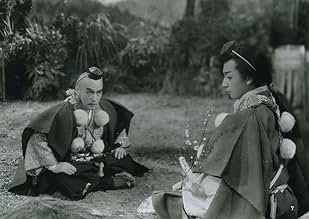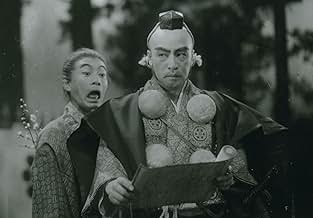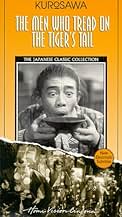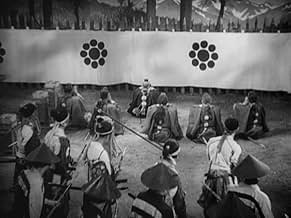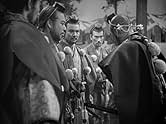Les hommes qui marchèrent sur la queue du tigre
Titre original : Tora no o o fumu otoko-tachi
- 1945
- Tous publics
- 59min
NOTE IMDb
6,7/10
4,7 k
MA NOTE
Un général japonais et ses hommes se déguisent en moines pour franchir un poste frontière ennemi.Un général japonais et ses hommes se déguisent en moines pour franchir un poste frontière ennemi.Un général japonais et ses hommes se déguisent en moines pour franchir un poste frontière ennemi.
- Réalisation
- Scénario
- Casting principal
Avis à la une
I chose to watch this on the way home from a trip where Japanese heritage was central. I have saved this early Kurosawa for such a special occasion, knowing that it would be heavily stylized. I thought that would detract from the effect; surely that is what most commentors say.
Cinematically, this has the essential Kurosawa: layered staging, profound cosmic forces testing human resources and strong character extremes.
The central character is disowned royalty, determined to set things right. We see little of him, and not even his face until things are nearly over.
I believe that it is Kurosawa's intention that he be the watcher and motivator both. As our on screen surrogate, this places us as both the watcher and the governing truths. It is a very clever reversal of the tradition, strong even then and even in Japan. The reversal is overt: he/we displace a comic porter, a simpleton that in a slightly less modern story would be the watcher.
He does watch, but as the thing evolves, he becomes more and more a featured act. Coming at the beginning of Kurosawa's career, it is tempting to think of this as paired with "Ran," the fool of the beginning to the King Lear of the end. This fool is not wise, but he is present in a way that no one else is, allowing us to carry the film.
The "film within" in this case is an impromptu prospectus for a rebuilt temple. I know of no more dramatically effective sequence than this, witnessed by an honorable man who takes the blessing seriously, and a foppish villain who creeps around during the speech. These are the fundamentals. As time would go, he could work with something better than a two-layered sound stage, and more complex narratives than this simple vignette. But I think the soul and sound of this is every bit as good as his best.
Ted's Evaluation -- 3 of 3: Worth watching.
Cinematically, this has the essential Kurosawa: layered staging, profound cosmic forces testing human resources and strong character extremes.
The central character is disowned royalty, determined to set things right. We see little of him, and not even his face until things are nearly over.
I believe that it is Kurosawa's intention that he be the watcher and motivator both. As our on screen surrogate, this places us as both the watcher and the governing truths. It is a very clever reversal of the tradition, strong even then and even in Japan. The reversal is overt: he/we displace a comic porter, a simpleton that in a slightly less modern story would be the watcher.
He does watch, but as the thing evolves, he becomes more and more a featured act. Coming at the beginning of Kurosawa's career, it is tempting to think of this as paired with "Ran," the fool of the beginning to the King Lear of the end. This fool is not wise, but he is present in a way that no one else is, allowing us to carry the film.
The "film within" in this case is an impromptu prospectus for a rebuilt temple. I know of no more dramatically effective sequence than this, witnessed by an honorable man who takes the blessing seriously, and a foppish villain who creeps around during the speech. These are the fundamentals. As time would go, he could work with something better than a two-layered sound stage, and more complex narratives than this simple vignette. But I think the soul and sound of this is every bit as good as his best.
Ted's Evaluation -- 3 of 3: Worth watching.
Akira Kurosawa was, well, a genius.
This early film is only further proof.
Before he made Rashomon, the Seven Samurai and Ran he made this and it's great.
The cast is fantastic. Kenichi Enomoto is especially great as the porter. That character is brilliant comic relief, which is especially evident in the scene where he attempts to dance.
Jason Biggs doing a stupid dance in American Pie is not funny. Kenichi Enomoto doing a stupid dance in Tora no o wo fumu otokotachi is.
The rest of the cast is great, too.
The characters are wonderful. There's of course the cowardly porter, and the clever character who, pretending to be a monk, has to think quickly and it's fun to watch.
Not only that, there is some very fine music and dialogue in this.
Only problem: Too short. . . but then again, I could say the same about the Seven Samurai and Ran. A great movie is always too short.
Highly recommended.
This early film is only further proof.
Before he made Rashomon, the Seven Samurai and Ran he made this and it's great.
The cast is fantastic. Kenichi Enomoto is especially great as the porter. That character is brilliant comic relief, which is especially evident in the scene where he attempts to dance.
Jason Biggs doing a stupid dance in American Pie is not funny. Kenichi Enomoto doing a stupid dance in Tora no o wo fumu otokotachi is.
The rest of the cast is great, too.
The characters are wonderful. There's of course the cowardly porter, and the clever character who, pretending to be a monk, has to think quickly and it's fun to watch.
Not only that, there is some very fine music and dialogue in this.
Only problem: Too short. . . but then again, I could say the same about the Seven Samurai and Ran. A great movie is always too short.
Highly recommended.
This is a very intelligent movie, telling the story of two men who ride the tiger's tail out of loyalty and grace. The courage of one of them is explicitly portrayed in the film. It is the samurai Benkei who cleverly defends his lord at a very high personal risk. Benkei improvises an eloquent speech reading out of a blank scroll the prospectus for the temple when required to do so by the commander of the military outpost seeking to capture his master. Benkei uses logic to convince his comrades that it is not a good idea to fight the soldiers of the barrier. The samurai may kill all the soldiers this time but that will result in more soldiers and more persecution later on. Benkei uses a clever trick, to flog his master who is posing as a porter when the second-in-command suspects that the porter is the master they are trying to capture. Since a servant would never beat his master, the porter cannot be the master, reasons the top commander.
But more impressive than Benkei is the street-wise guy, the real porter played by Kenichi Enomoto, who joins the party of samurai in the forest. He treads on two tigers' tails. The first tiger is represented by the party of samurai. He is rejected by them, he is called a nobody, he is treated harshly, he is even threatened with death. He disappears at times but he returns to help the samurai who walk in the forest pretending to be itinerant priests. He collects information valuable to them and shares that information. And the second tiger is the military outpost who will surely kill him if they discover that the master is among the party of fake itinerant priests.
While Benkei does his heroic deeds in a ceremonial manner framed by rituals and high tension, the loquacious porter does his heroic deeds in a discreet, even awkward manner, without fanfare or rituals. His heroism is so discreet that even seasoned Kurosawa critics missed the point of the movie: natural, humble heroism offered not out of loyalty, but out of grace.
(The master of the party of samurai is such an obscure figure that out of respect to Kurosawa I have not even mentioned his name in my review)
But more impressive than Benkei is the street-wise guy, the real porter played by Kenichi Enomoto, who joins the party of samurai in the forest. He treads on two tigers' tails. The first tiger is represented by the party of samurai. He is rejected by them, he is called a nobody, he is treated harshly, he is even threatened with death. He disappears at times but he returns to help the samurai who walk in the forest pretending to be itinerant priests. He collects information valuable to them and shares that information. And the second tiger is the military outpost who will surely kill him if they discover that the master is among the party of fake itinerant priests.
While Benkei does his heroic deeds in a ceremonial manner framed by rituals and high tension, the loquacious porter does his heroic deeds in a discreet, even awkward manner, without fanfare or rituals. His heroism is so discreet that even seasoned Kurosawa critics missed the point of the movie: natural, humble heroism offered not out of loyalty, but out of grace.
(The master of the party of samurai is such an obscure figure that out of respect to Kurosawa I have not even mentioned his name in my review)
This film is just less than an hour long and tells a simple tale about a warrior with his six followers (one is a "driver" who almost reminds me of a Japanese Stan Laurel) and their quest to move on. They disguise themselves as monks. The film is set in the year 1195. The second half of the film is better, where they have to prove to others that they indeed are monks. The tension, including facing otherwise certain death, is extremely well done. I labeled the film curious due to its simplicity in telling the story. Kurosawa is rarely this straightforward, usually there are interesting twists and turns. That said, this watchable, there is a little comic relief, but it is not A list Kurosawa. Thats fine in and of itself.
One can, for the first time, in my opinion, see what Kurosawa could do. He follow a group. of men trying to get through a checkpoint, disguised as priests. Their leader is disguised as a porter and therefore must dishonored to be protected. This is all part of a legend in ancient China and the audiences pretty much knew the story. Kurosawa provides comic relief with the true porter who is an unforgettable character. He is one of those pests that drives one crazy, yet he is so persistent in his efforts to be included. Apparently, historically, things don't bode well for the future but the standoff that occurs as they pretty much risk their lives to get through is quite breathtaking. There are incredible images of the landscape and the use of closeups is vibrant and sharp. The porter's dance at the end is terrific, against a bank of clouds, silhouetted against the sky.
Le saviez-vous
- AnecdotesProduction had to be halted briefly during production of the film as Japan surrendered, bringing an end to the hostilities of World War II. Akira Kurosawa recollected breaking during production to listen to the address by Emperor Hirohito on August 15th, 1945.
- ConnexionsFeatured in Great Performances: Kurosawa (2000)
Meilleurs choix
Connectez-vous pour évaluer et suivre la liste de favoris afin de recevoir des recommandations personnalisées
- How long is The Men Who Tread on the Tiger's Tail?Alimenté par Alexa
Détails
- Date de sortie
- Pays d’origine
- Langue
- Aussi connu sous le nom de
- Qui marche sur la queue du tigre...
- Lieux de tournage
- Toho Studios, Tokyo, Japon(Studio)
- Société de production
- Voir plus de crédits d'entreprise sur IMDbPro
- Durée
- 59min
- Couleur
- Mixage
- Rapport de forme
- 1.37 : 1
Contribuer à cette page
Suggérer une modification ou ajouter du contenu manquant

